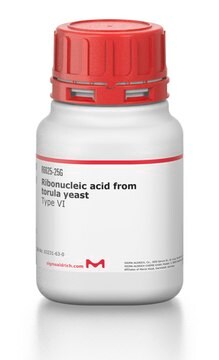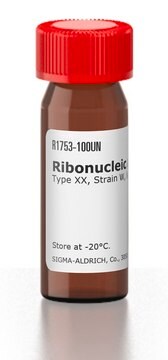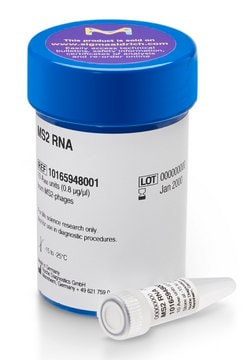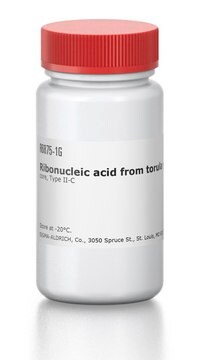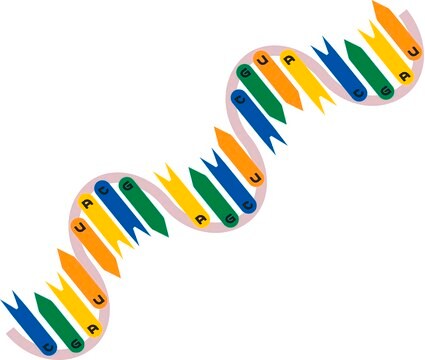R6750
Ribonukleinsäure aus Backhefe (S. cerevisiae)
Synonym(e):
RNA
Anmeldenzur Ansicht organisationsspezifischer und vertraglich vereinbarter Preise
Alle Fotos(4)
About This Item
Empfohlene Produkte
Qualitätsniveau
Lagertemp.
−20°C
Suchen Sie nach ähnlichen Produkten? Aufrufen Leitfaden zum Produktvergleich
Verwandte Kategorien
Allgemeine Beschreibung
Ribonukleinsäure (RNA) aus Backhefe (S. Cerevisiae) ist ein Substrat für das RNase-Enzym. Die Isolierung von RNA aus Hefe ist ein kompliziertes Verfahren und involviert Zyklen von Erwärmen und Einfrieren von Zellen in Gegenwart von Phenyl und Detergenzien (SDS).
Anwendung
Ribonukleinsäure (RNA) aus Backhefe (S. Cerevisiae) eignet sich für Anwendungen wie Northern-Blot-Hybridisierung, Reverse-Transkriptase-Polymerase-Kettenreaktion (RT-PCR) und cDNA-Konstruktion.
Angaben zur Herstellung
Hergestellt durch eine Modifikation von Crestfield, A.M., et al., J. Biol. Chem., 216, 185 (1955).
Lagerklassenschlüssel
11 - Combustible Solids
WGK
WGK 3
Flammpunkt (°F)
Not applicable
Flammpunkt (°C)
Not applicable
Persönliche Schutzausrüstung
Eyeshields, Gloves, type N95 (US)
Hier finden Sie alle aktuellen Versionen:
Besitzen Sie dieses Produkt bereits?
In der Dokumentenbibliothek finden Sie die Dokumentation zu den Produkten, die Sie kürzlich erworben haben.
Kunden haben sich ebenfalls angesehen
Lukas Bossaller et al.
Journal of immunology (Baltimore, Md. : 1950), 197(4), 1044-1053 (2016-06-30)
Systemic lupus erythematosus (SLE) is a chronic, life-threatening autoimmune disorder, leading to multiple organ pathologies and kidney destruction. Analyses of numerous murine models of spontaneous SLE have revealed a critical role for endosomal TLRs in the production of autoantibodies and
Hidekazu Iioka et al.
Nucleic acids research, 39(8), e53-e53 (2011-02-09)
The diverse localization of transcripts in cells suggests that there are many specific RNA-protein interactions that have yet to be identified. Progress has been limited, however, by the lack of a robust method to detect and isolate the RNA-binding proteins.
Michael R Green et al.
Cold Spring Harbor protocols, 2021(12) (2021-12-03)
Isolation of RNA from yeast is complicated by the need to first break the thick, rigid cell wall. The protocol provided here uses a cycle of heating and freezing of cells in the presence of phenol and the detergent sodium
Stephanie C Bannister et al.
Biology of reproduction, 81(1), 165-176 (2009-04-10)
MicroRNAs are a highly conserved class of small RNAs that function in a sequence-specific manner to posttranscriptionally regulate gene expression. Tissue-specific miRNA expression studies have discovered numerous functions for miRNAs in various aspects of embryogenesis, but a role for miRNAs
Hilal Kazan et al.
Nucleic acids research, 41(Web Server issue), W180-W186 (2013-06-12)
RBPmotif web server (http://www.rnamotif.org) implements tools to identify binding preferences of RNA-binding proteins (RBPs). Given a set of sequences that are known to be bound and unbound by the RBP of interest, RBPmotif provides two types of analysis: (i) de
Protokolle
This procedure may be used for determination of Ribonuclease A (RNase A) activity.
Unser Team von Wissenschaftlern verfügt über Erfahrung in allen Forschungsbereichen einschließlich Life Science, Materialwissenschaften, chemischer Synthese, Chromatographie, Analytik und vielen mehr..
Setzen Sie sich mit dem technischen Dienst in Verbindung.
